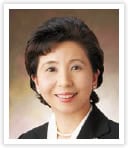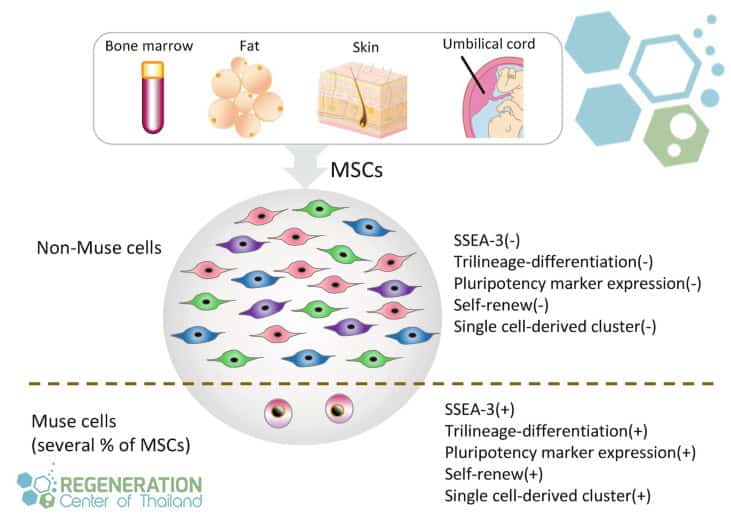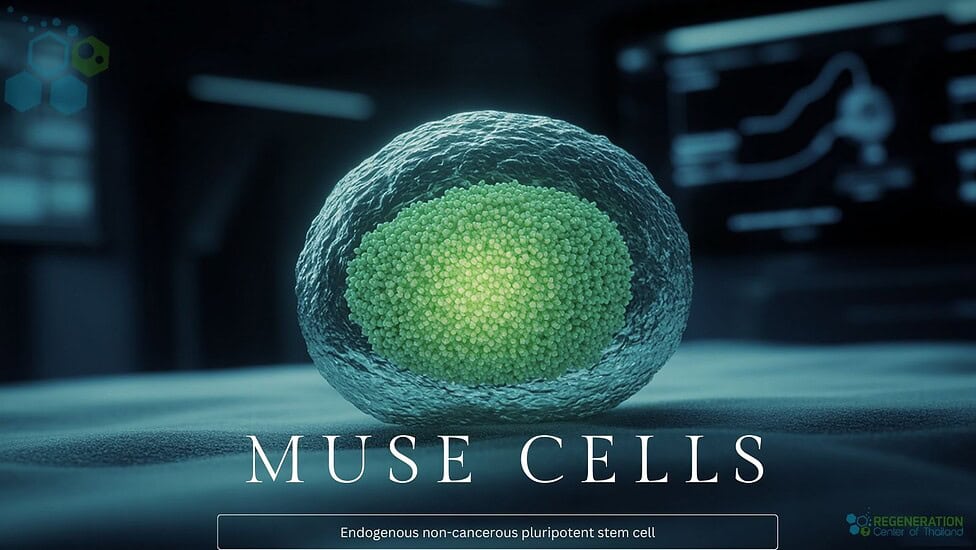“Muse cells” were first discovered in 2010 and offer enhanced pluripotency compared to traditional mesenchymal stem cells (MSCs). These unique cells express pluripotency markers and can differentiate into all three germ layers, surpassing the capabilities of typical MSCs. Muse cells possess remarkable stress resistance and immune-modulatory properties, making them ideal for allogeneic transplantation. Their ability to home to damaged tissues and differentiate into various cell types positions them as promising candidates for regenerative medicine and cellular therapies for strokes, parkinsons disease, ALS, MND, kidney failure, ulcerative colitis, liver failure and autoimmune diseases such as rheumatoid arthritis. While challenges in isolation and standardization exist, ongoing research and clinical trials explore Muse cells’ potential in treating neurodegenerative diseases, injuries, and other medical conditions. The Regeneration Center believes the future of Muse cell research holds exciting possibilities for patient care.
Understanding Muse Cells
Muse cells (Multilineage-differentiating stress-enduring cells) represent a distinct population with unique characteristics among stem cells. First identified in 2010, these cells have garnered significant attention in regenerative medicine due to their remarkable properties.
Muse cells are characterized by their ability to withstand severe cellular stress and differentiate into various cell lineages. Unlike other stem cells, Muse cells can be isolated from a wide range of tissues, including bone marrow, adipose tissue, and skin fibroblasts. Isolation techniques typically involve subjecting the source tissue to harsh conditions, such as long-term trypsin incubation or exposure to low temperatures, which selectively enrich Muse cells. Gene expression analysis revealed that Muse cells express pluripotency markers, such as Oct3/4, Sox2, and Nanog, albeit at lower levels than embryonic stem cells. This unique gene expression profile contributes to their capacity for self-renewal and differentiation into cells from all three germ layers.
Muse cells’ immunological aspects are particularly intriguing. These cells exhibit low immunogenicity and immunomodulatory properties, making them attractive candidates for allogeneic transplantation. Comparison studies have demonstrated that Muse cells have advantages over mesenchymal stem cells regarding their differentiation potential and therapeutic efficacy.
As our research on Muse cells advances, their potential applications in regenerative medicine and cell-based therapies become increasingly apparent. The unique combination of stress resistance, pluripotency, and immunological properties makes Muse cells a promising tool for addressing various medical challenges at the Regeneration Center.
Discovery and Identification
The discovery of Muse cells marked a significant milestone in stem cell research, offering new insights into cellular pluripotency and regenerative potential. These unique cells were first  identified in 2010 by a team of Japanese researchers led by Dr. Mari Dezawa. Their groundbreaking work revealed a subset of mesenchymal stem cells with remarkable properties,
identified in 2010 by a team of Japanese researchers led by Dr. Mari Dezawa. Their groundbreaking work revealed a subset of mesenchymal stem cells with remarkable properties,
Isolation techniques played an essential role in the identification of Muse cells. Researchers developed specialized methods to separate these rare cells from heterogeneous populations, including stress-induced selection and flow cytometry. Identifying specific cellular markers, such as SSEA-3 and CD105, further facilitated the characterization of Muse cells and their distinction from other stem cell types.
As the international scientific community accepted this discovery, researchers worldwide began investigating Muse cells’ potential applications in regenerative medicine. However, challenges emerged, including donor variability and the need for optimized culture conditions to maintain Muse cell properties. These factors influenced the reproducibility of results and highlighted the importance of standardized protocols in Muse cell research.
Ethical considerations surrounding stem cell research also apply to Muse cells, although to a lesser extent than embryonic stem cells. The ability to isolate Muse cells from adult tissues mitigates some ethical concerns, making them an attractive alternative for researchers and clinicians seeking pluripotent cell sources. As our understanding of Muse cells grows, so does the potential for their use in personalized medicine and tissue regeneration, offering hope to patients with previously untreatable conditions.
Unique Properties of Muse Cells
Muse cells possess several distinctive characteristics that set them apart from other stem cell types. These unique properties contribute to their exceptional regenerative capacity and potential  for therapeutic applications. One of the most notable features of Muse cells is their ability to differentiate into cells from all three germ layers, demonstrating a level of cellular plasticity that surpasses that of typical mesenchymal stem cells.
for therapeutic applications. One of the most notable features of Muse cells is their ability to differentiate into cells from all three germ layers, demonstrating a level of cellular plasticity that surpasses that of typical mesenchymal stem cells.
Another critical attribute of Muse cells is their intrinsic immune-modulatory properties. This characteristic allows them to evade immune rejection and promote tissue repair without triggering inflammatory responses. As a result, Muse cells can be transplanted across different individuals without the need for immunosuppression, making them valuable candidates for allogeneic cell therapies. Muse cells also exhibit unique niche interactions, allowing them to home to damaged tissues and integrate seamlessly into the local environment. This property enhances their ability to contribute to tissue regeneration and repair. In addition, Muse cells have shown remarkable resistance to cellular stress, enabling them to survive in harsh conditions detrimental to other cell types.
These unique characteristics make Muse cells a promising tool for regenerative medicine. Their ability to differentiate into various cell types, modulate immune responses, and adapt to different tissue environments positions them as versatile therapeutic agents. As research progresses, the distinctive properties of Muse cells continue to inspire new approaches in stem cell-based treatments, offering hope for individuals seeking innovative solutions to complex medical conditions.
Differentiation Potential
Differentiation potential is a cornerstone of Muse cells, setting them apart in regenerative medicine. These unique cells exhibit remarkable plasticity, capable of differentiating into various cell types across all three germ layers: endoderm, mesoderm, and ectoderm. This exceptional ability positions Muse cells as a bridge between pluripotent and multipotent stem cells, offering hope for those seeking advanced therapeutic options at the Regeneration Center.
Muse cells demonstrate an array of differentiation pathways, far surpassing the limitations of traditional mesenchymal stem cells. While they retain the capacity to differentiate along the mesenchymal lineage, Muse cells also possess the potential to form cells of ectodermal and endodermal origin. This expanded differentiation repertoire allows Muse cells to contribute to a broader range of tissue repair and regeneration processes. Various factors, including niche influences and environmental cues, influence the plasticity mechanisms underlying Muse cell differentiation. These cells respond dynamically to their surroundings, adapting their differentiation trajectory based on the specific needs of the tissue microenvironment. This adaptability makes Muse cells particularly valuable in functional healthcare and regenerative medicine applications, where they can address diverse tissue repair requirements.
Muse cells express a unique combination of stem cell markers, including those associated with both pluripotent and mesenchymal stem cells. This distinctive marker profile reflects their enhanced differentiation potential and contributes to their ability to steer through multiple lineage pathways. As research in this field progresses, understanding the intricate interplay between these markers and differentiation potential will be vital in utilizing the full therapeutic potential of Muse cells.
Therapeutic Applications of Muse Stem Cells
Given their remarkable differentiation potential, Muse cells have emerged as promising candidates for various therapeutic applications. These cells have garnered significant attention in regenerative medicine, offering hope for patients with previously untreatable conditions. The Regeneration Center is exploring the use of Muse cells in cellular therapies for a wide range of diseases and injuries.
Clinical trials involving Muse cells are underway for several conditions, including traumatic brain injuries, spinal cord injury, heart disease and myocardial infarctions. Our research aim to utilize the cells’ ability to differentiate into specific tissue types and promote healing. In tissue engineering, Muse cells show potential for creating complex, three-dimensional structures that can replace damaged or diseased tissues.
One critical advantage of Muse cells in therapeutic applications is their immune-privileged nature. This characteristic allows for allogeneic transplantation without needing immunosuppression, reducing the risk of rejection and simplifying treatment protocols. Additionally, Muse cells have demonstrated immune modulation properties, which may prove beneficial in treating autoimmune disorders and reducing inflammation in various pathological conditions. The versatility of Muse cells extends to their potential use in combination therapies at the Regeneration Stem Cell Center.
Challenges & Risks of Muse Cells
Charting the complex terrain of Muse cells presents several significant challenges that researchers must address to realize these cells’ therapeutic potential fully. As we commence this expedition together, we have had to traverse the intricate environment of scientific, ethical, and practical hurdles that come with the new technology. Refining isolation techniques is one of our primary obstacles when isolating the Muse cells. Current methods for extracting these rare cells from various tissues are often time-consuming and yield limited quantities. Developing more efficient and reliable isolation protocols is essential for advancing our understanding and application of Muse cells.
Traversing the complex environment of regulatory approvals and addressing ethical concerns surrounding stem cell research are essential steps in translating laboratory findings into clinical applications. Working together to address these challenges can pave the way for groundbreaking discoveries and treatments that will benefit humanity.

Future Directions and Possibilities
The horizon of Muse cell research brims with exciting possibilities and potential breakthroughs. As we advance our understanding of these pluripotent cells, the medical community is poised to reveal new avenues in regenerative medicine. Clinical trials involving Muse cells are expected to expand, offering hope for patients with previously untreatable conditions. These trials will likely focus on a wide range of applications, from neurological disorders to cardiovascular diseases, showcasing the versatility of Muse cells in tissue repair and regeneration.
The future of Muse cell research also hinges on increased funding opportunities and the establishment of robust international collaboration networks. As more healthcare systems recognize the potential of these cells, we anticipate a surge in support from both the public and private sectors. This influx will accelerate our research efforts and facilitate the translation of laboratory findings into clinical applications. Additionally, forming international research consortia will promote knowledge exchange and streamline the development of Muse cell-based therapies.
As we progress, addressing ethical considerations surrounding using Muse cells in regenerative medicine is essential. Unlike embryonic stem cells, Muse cells offer a less controversial alternative, potentially easing regulatory hurdles and public acceptance. However, we must remain vigilant in adhering to ethical guidelines and ensuring transparent communication with the public. By steering through these challenges responsibly, we can utilize the full potential of Muse cells to transform patient care and advance the field of regenerative medicine.

